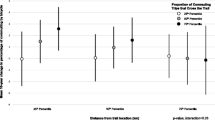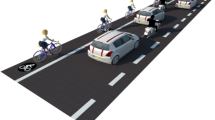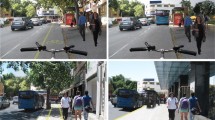Abstract
When using limited funds on bicycle facilities, it would be helpful to know the extent to which a new facility will be used. If a bicycle lane is added to a street, how many bicyclists will no longer use the adjacent sidewalk? If a separate bicycle path is constructed, how many bicyclists will move from the street or sidewalk? This study seeks to identify factors that explain a bicyclist’s choice between available facility choices—off-street (sidewalk and bicycle path) or on-street (bicycle lane and roadway). This paper investigates these issues through a survey of bicyclists headed to Purdue University in West Lafayette, IN, USA. The first data collected to address these questions were “site-based”. Bicyclists were interviewed on campus at the end of their trips and asked which part of the cross-sections along their routes they had used—on-street or off-street. The characteristics of a particular cross-section of street right-of-way were then compared against the characteristics of each bicyclist and his/her observed choice of street, sidewalk, lane, or path. Later, “route-based” serial data were also added. The study developed a mixed logit model to analyze the bicyclists’ facility preferences and capture the unobserved heterogeneity across the population. Effective sidewalk width, traffic signals, segment length, road functional class, street pavement condition, and one-way street configuration were found to be statistically significant. A bicycle path is found to be more attractive than a bicycle lane. Predictions from the model can indicate where investments in particular bicycle facilities would have the most desirable response from bicyclists.
Similar content being viewed by others
References
Antonakos, C.L.: Research issues on bicycling, pedestrians, and older drivers. Environmental and travel preference of cyclists. Transp. Res. Rec. 1438, 29–31 (1994)
Aultman-Hall, L., Adams, J.R.M.F.: Sidewalk bicycling safety issues. Transp. Res. Rec. 1636, 71–76 (1998)
Bartus, T.: Estimation of marginal effects using margeff. Stata J 3, 309–329 (2005)
Ben-Akiva, M., Lerman, S.R.: Discrete choice analysis: theory and application to predict travel demand, pp. 69–70. MIT Press, Cambridge (1985)
Bhat, C.: Quasi-random maximum simulated likelihood estimation of the mixed multinomial Mogit model. Transp. Res. B 37, 677–693 (2001)
Bhat, C.: Simulation estimation of mixed discrete choice models using randomized and scrambled Halton sequences. Transp. Res. B 37, 837–855 (2003)
Buehler, R., Pucher, J.: Cycling to work in 90 large American cities: new evidence on the role of bicycle paths and lanes. Transportation 39, 409–432 (2012)
de Geus, B., De Smet, S., Nijs, J., Meeusen, R.: Determining the intensity and energy expenditure during commuter cycling. Br. J. Sports Med. 41, 8–12 (2007)
Dill, J., Carr, T.: Bicycle commuting and facilities in major U.S. cities: if you build them, commuters will use them. Transp. Res. Rec. 1828, 116–123 (2003)
Federal Highway Administration: National bicycling and walking study, case study no. 1: reasons why bicycling and walking are not being used more extensively as travel modes. U.S. Department of Transportation, Washington (1992)
Ford, K.M., Fricker, J.D., Brown, J.M.: Discrete choice analysis of bicyclist cross-sectional behavior. 90th Annual Meeting of the Transportation Research Board, Paper #11-0956, 23–26 Jan 2011
Greene, W.H.: Econometric analysis, 5th edn. Prentice-Hall, Upper Saddle River (2002)
Halton, J.: On the efficiency of evaluating certain quasi-random sequences of points in evaluating multi-dimensional integrals. Numer. Math. 2(1), 84–90 (1960)
Harkey, D.L., Reinfurt, D.W., Knuiman, M., Stewart, J.R., Sorton, A.: Development of the bicycle compatibility index: a level of service approach. Federal Highway Administration, Report FHWA-RD-98-072. Chapel Hill (1998)
Harvey, F., Krizek, K.J., Collins, R.: Using GPS data to assess bicycle commuter route choice. Compendium of papers DVD, 87th Annual Meeting of the Transportation Research Board, Paper #08-2951, 13–15 Jan 2008
Heckman, J.: Statistical models for discrete panel data. In: Manski, C., McFadden, D. (eds.) Structural analysis of discrete data with econometric applications. MIT Press, Cambridge (1981)
Heinen, E., Van Wee, B., Maat, K.: Commuting by bicycle: an overview of the literature. Transp. Rev. 30(1), 59–96 (2010)
Highway capacity manual: Special Report 209. National Research Council, Washington (1994)
Highway capacity manual: Transportation Research Board. National Research Council, Washington (2010)
Hunt, J.D., Abraham, J.E.: Influences on bicycle use. Transportation 34, 453–470 (2007)
Hunter, W.W., Stewart, J.R., Stutts, J.C.: Study of bicycle lanes versus wide curb. Transp. Res. Rec. 1674, 70–77 (1999)
Klobucar, M., Fricker, J.D.: Network evaluation tool to improve real and perceived bicycle safety. Transp. Res. Rec. 2031, 25–33 (2007)
Krizek, K.J., Barnes, G., Thompson, K.: Analyzing the effects of bicycle facilities on commute mode share over time. J. Urban Plan. Dev. 135(2), 66–73 (2009)
Krizek, K.J., Johnson, P., Tilahun, N.: Gender differences in bicycling behavior and facility preferences. In: Rosenbloom, S. (ed.) Research on women’s issues in transportation, special report, vol. 2, pp. 31–40. National Academy Press/Transportation Research Board, Washington (2005)
Lawlor, D.A., Ness, A.R., Cope, A.M., Insall, P., Riddoch, C.: The challenges of evaluating environmental interventions to increase population levels of physical activity: the case of the UK National Cycle Network. J. Epidemiol. Community Health 57(2), 96–101 (2003)
League of Illinois Bicyclists.: Polls Show Americans Want Better Biking. http://www.bicyclelib.org/tbills/americanswant.htm (2003). Accessed 10 July 2009
Meuleners, L.B., Lee, A.H., Haworth, C.: Road environment, crash type and hospitalization of bicyclists and motorcyclists presented to emergency departments in western Australia. Accid. Anal. Prev. 39, 1222–1225 (2007)
NACTO: NACTO urban bikeway design guide, contra-flow bike lanes, National Association of City Transportation Officials, http://nacto.org/cities-for-cycling/design-guide/bike-lanes/contra-flow-bike-lane/ (2012). Accessed 15 May 2012
Nelson, A.C., Allen, D.: If you build them, commuters will use them: association between bicycle facilities and bicycle commuting. Transp. Res. Rec. 1578, 79–83 (1997)
Parkin, J., Wardman, M., Page, M.: Estimation of the determinants of bicycle mode share for the journey to work using census data. Transportation 35, 93–109 (2008)
Pucher, J., Dill, J., Handy, S.: Infrastructure, programs, and policies to increase bicycling: an international review. Prev. Med. 50, 106–125 (2010)
Sener, I.N., Eluru, N., Bhat, C.: An analysis of bicycle route choice preferences in Texas, US. Transportation 36, 511–539 (2009)
Stinson, M.A., Bhat, C.R.: A comparison of the route preferences of experienced and inexperienced bicycle commuters. Presented at 84th annual meeting of the Transportation Research Board, Washington, 9–13 Jan 2005
Taylor, D., Mahmassani, H.: Analysis of stated preferences for intermodal bicycle-transit interfaces. Transp. Res. Rec. 1556, 86–95 (1996)
Tilahun, N.Y., Levinson, D.M., Krizek, K.: Trails, lanes, or traffic: valuing bicycle facilities with an adaptive stated preference survey. Transp. Res. A 41, 287–301 (2007)
Train. K.: Halton Sequences for Mixed Logit. Working Paper, Department of Economics, University of California, Berkeley (1999)
Wachtel, A., Lewiston, D.: Risk factors for bicycle-motor vehicle collisions at intersections. ITE Journal 64, 30–35 (1994)
Walker, D.: PASER manuals—concrete and asphalt. Wisconsin Transportation Information Center, 432 North Lake Street, Madison, WI 53706, USA. tic.engr.wisc.edu (2002). Accessed 16 April 2012
Washington, S., Karlaftis, M., Mannering, F.L.: Statistical and econometric methods for transportation data analysis, 2nd edn. Chapman & Hall/CRC, Boca Raton (2011)
Acknowledgments
The authors thank Professor Fred Mannering at Purdue University for his guidance and suggestions on model estimation. The authors appreciate the helpful comments of three anonymous reviewers on an earlier version of the paper. The authors acknowledge the efforts of Jennifer Brown and Kevin Ford in preparing the original data set. Yingge Xiong also provided some thoughtful ideas for this paper.
Author information
Authors and Affiliations
Corresponding author
Rights and permissions
About this article
Cite this article
Kang, L., Fricker, J.D. Bicyclist commuters’ choice of on-street versus off-street route segments. Transportation 40, 887–902 (2013). https://doi.org/10.1007/s11116-013-9453-x
Published:
Issue Date:
DOI: https://doi.org/10.1007/s11116-013-9453-x




